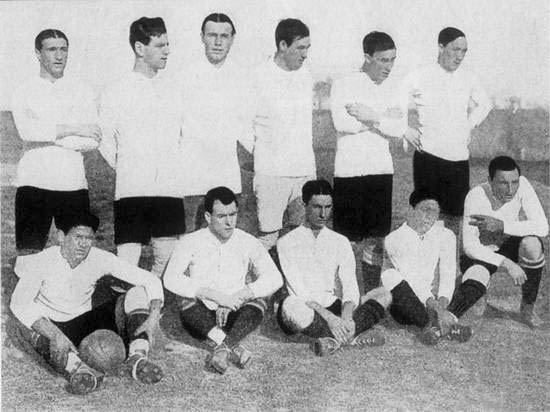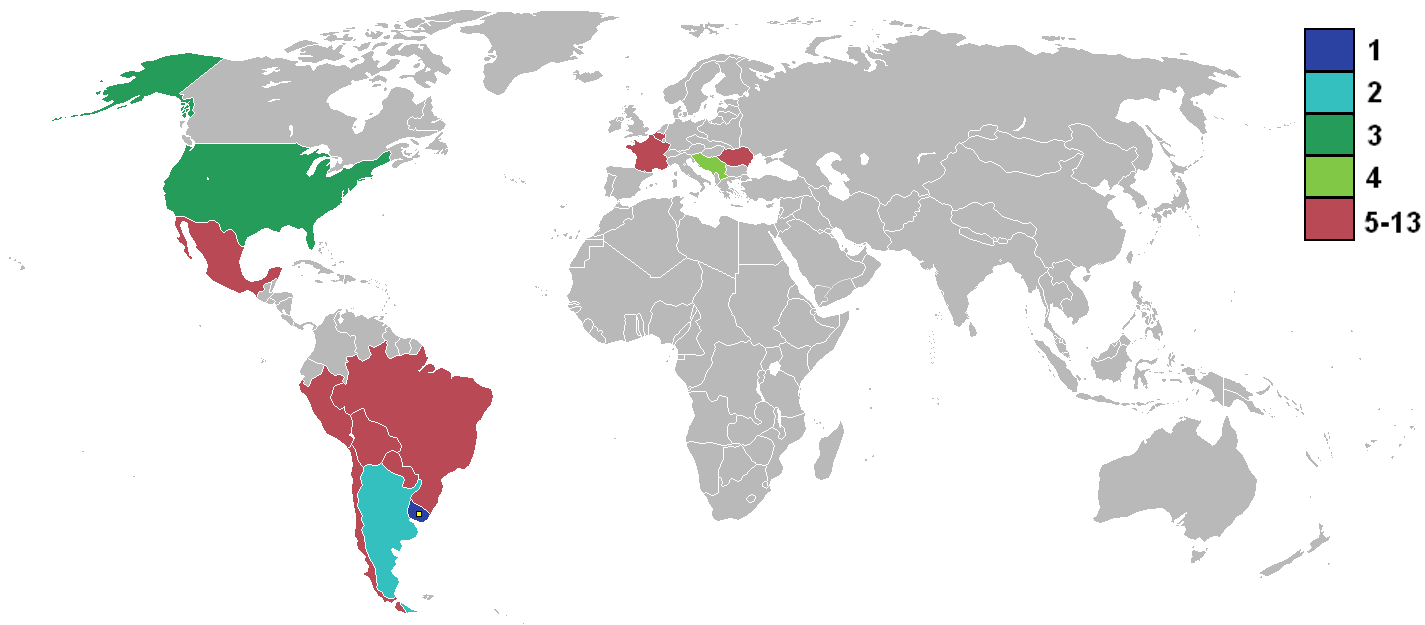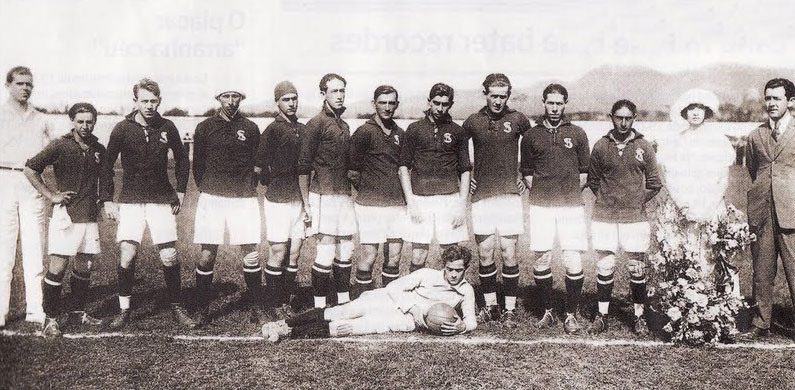|
1989 Recopa Sudamericana
The 1989 Recopa Sudamericana was the first Recopa Sudamericana, a football competition for South American clubs that won the previous year's two most important competitions in the continent: the Copa Libertadores and the Supercopa Sudamericana. The inaugural edition was disputed between Nacional, winners of the 1988 Copa Libertadores, and Racing, winners of the 1988 Supercopa Sudamericana. The first leg was played on January 31 in Montevideo, while the second leg was played in Buenos Aires on February 6. Nacional won the final series 4-1 on points as Daniel Fonseca of Nacional scored the first goal of the competition as well as the only one in this final. Qualified teams Rules The Recopa Sudamericana was played over two legs; home and away. The team that qualified via the Copa Libertadores played the first leg at home. The team that accumulated the most points —two for a win, one for a draw, zero for a loss— after the two legs was crowned the champion. In case of both t ... [...More Info...] [...Related Items...] OR: [Wikipedia] [Google] [Baidu] |
Recopa Sudamericana
The CONMEBOL Recopa Sudamericana ( pt, CONMEBOL Recopa Sul-Americana), known also as the Recopa Sudamericana or CONMEBOL Recopa, and simply as the Recopa (, ; "Winners' Cup"), is an annual international club football competition organized by CONMEBOL since 1988. It is a match-up between the champions of the previous year's Copa Libertadores and the Copa Sudamericana, South America's premier club competitions. The competition has had several formats over its lifetime. Initially, the champions of the Copa Libertadores and Supercopa Libertadores contested it. In 1998, the Supercopa Libertadores was discontinued and the ''Recopa'' went into a hiatus. The competition has been disputed with either a presently-used two-legged series or a single match-up at a neutral venue. Together with the aforementioned tournaments, a club has the chance to win the ''CONMEBOL Treble'' all in one year or season. However, if the Copa Libertadores and Copa Sudamericana are won by the same team, the ... [...More Info...] [...Related Items...] OR: [Wikipedia] [Google] [Baidu] |
1988 Supercopa Sudamericana
The 1988 Supercopa Libertadores was the inaugural year of the competition. The tournament was open to all the past winners of the Copa Libertadores. It commenced on 10 February and concluded on 18 June. A total of 13 football clubs entered the first round draw. It was won by Argentinian side Racing over Brazilian side Cruzeiro 3–2 on aggregate after a two-legged final. The tournament's top scorer was Sergio Oliveira of Nacional and Antonio Alzamendi of River Plate with 4 goals each. Qualified teams Up until the beginning of 1988, thirteen teams had won the Copa Libertadores at least once since its inaugural season in 1960. Knockout bracket * Although Racing and Santos FC played in a first round tie, their series was placed in the quarterfinals due to the winner Racing getting a bye to the semifinal. First stage The matches were played from 10 February to 20 April. Teams from the same nation could not be drawn against one another. * Nacional received a bye to the ... [...More Info...] [...Related Items...] OR: [Wikipedia] [Google] [Baidu] |
1960 Copa Libertadores
The 1960 Copa de Campeones de América was the first season of the Copa CONMEBOL Libertadores, CONMEBOL's premier club tournament. Seven association's clubs entered the first competition, with three not sending a representative. The first match of the tournament was played between Uruguayan side Peñarol and Bolivian side Jorge Wilstermann on April 19 in Montevideo, Uruguay. During that game, Ausberto García of Jorge Wilstermann became the first player to move the ball in the tournament setting the motions for what is to become one of the most prestigious competitions in the world. Carlos Borges of Peñarol scored the first goal of the tournament, with teammate and legendary figure Alberto Spencer scoring the first hat-trick. Peñarol would go to become the first South American club champion after defeating the Olimpia in the finals. With the subsequent results on later editions, Peñarol became the most successful club in the competition until 1973. Background CONMEBOL, the ... [...More Info...] [...Related Items...] OR: [Wikipedia] [Google] [Baidu] |
Copa América 1995
Copa or COPA may refer to: COPA COPA may refer to: * Computer Operator Programming Assistant. trade of ITI * Child Online Protection Act, a former U.S. law to protect minors from certain material on the internet * Canadian Owners and Pilots Association * Cirrus Owners and Pilots Association * Parliamentary Conference of the Americas * COPA (gene), a human gene that encodes the coatomer subunit alpha protein * Controlling Profitability Analysis, Profitability Analysis (SAP) *COPA-COGECA, a union of European farmers Copa Copa may refer to: * Copa Heizung GmbH, COPA branded hydronic steel panel and bathroom radiator supplier based in Germany * Copa Airlines, an international airline based in Panama * Copa America, the main association football competition of the South American men's national football teams * ''Copa'' (spider), a genus of spiders in the family Corinnidae * Copacabana (nightclub), a nightclub in New York City * Copa Room, now-defunct Las Vegas nightclub at The San ... [...More Info...] [...Related Items...] OR: [Wikipedia] [Google] [Baidu] |
South American Championship 1942
The seventeenth edition of the South American Championship was held in Montevideo, Uruguay from 10 January to 7 February. For the first time seven teams took part of the event; the participating countries were Argentina, Brazil, Chile, Ecuador, Paraguay, Peru, and Uruguay. Bolivia, and Colombia withdrew from the tournament. The tournament featured a match between Argentina and Ecuador in which Argentina's José Manuel Moreno surpassed the 500-goal mark for goals in Copa América history, scoring 5 in a 12–0 drubbing of Ecuador. , the 12-goal difference of that match remains the widest ever in Copa Américas. José Manuel Moreno and Herminio Masantonio of Argentina were joint top scorers of the tournament, with 7 goals each. Squads Venues Final round Each team played against each of the other teams. Two points were awarded for a win, one point for a draw and no (0) points for a defeat. ---- ---- ---- ---- ---- ---- ---- ---- ---- ---- ---- ---- -- ... [...More Info...] [...Related Items...] OR: [Wikipedia] [Google] [Baidu] |
Copa América
The Copa América ( en, America Cup) or CONMEBOL Copa América, known until 1975 as the South American Football Championship (''Campeonato Sudamericano de Fútbol'' in Spanish and ''Campeonato Sul-Americano de Futebol'' in Portuguese), is the top men's football tournament contested among national teams from South America. It is the oldest still-running continental football competition, as well as the third most watched in the world. The competition determines the champions of South America. Since the 1990s, teams from North America and Asia have also been invited to compete. Since 1993, the tournament has generally featured 12 teams—all 10 CONMEBOL teams and two additional teams from other confederations. Mexico participated in every tournament between 1993 and 2016, with one additional team drawn from CONCACAF, except for 1999, when AFC team Japan filled out the 12-team roster, and 2019, which featured Japan and Qatar. The 2016 version of the event, Copa América Centena ... [...More Info...] [...Related Items...] OR: [Wikipedia] [Google] [Baidu] |
FIFA
FIFA (; stands for ''Fédération Internationale de Football Association'' (French), meaning International Association Football Federation ) is the international governing body of association football, beach football and futsal. It was founded in 1904 to oversee international competition among the national associations of Belgium, Denmark, France, Germany, the Netherlands, Spain, Sweden and Switzerland. Headquartered in Zürich, Switzerland, its membership now comprises 211 national associations. These national associations must each also be members of one of the six regional confederations into which the world is divided: CAF (Africa), AFC (Asia and Australia), UEFA (Europe), CONCACAF (North & Central America and the Caribbean), OFC (Oceania) and CONMEBOL (South America). FIFA outlines a number of objectives in the organizational Statutes, including growing association football internationally, providing efforts to ensure it is accessible to everyone, and advocating for ... [...More Info...] [...Related Items...] OR: [Wikipedia] [Google] [Baidu] |
Uruguay
Uruguay (; ), officially the Oriental Republic of Uruguay ( es, República Oriental del Uruguay), is a country in South America. It shares borders with Argentina to its west and southwest and Brazil to its north and northeast; while bordering the Río de la Plata to the south and the Atlantic Ocean to the southeast. It is part of the Southern Cone region of South America. Uruguay covers an area of approximately and has a population of an estimated 3.4 million, of whom around 2 million live in the metropolitan area of its capital and largest city, Montevideo. The area that became Uruguay was first inhabited by groups of hunter–gatherers 13,000 years ago. The predominant tribe at the moment of the arrival of Europeans was the Charrúa people, when the Portuguese first established Colónia do Sacramento in 1680; Uruguay was colonized by Europeans late relative to neighboring countries. The Spanish founded Montevideo as a military stronghold in the early 18th centur ... [...More Info...] [...Related Items...] OR: [Wikipedia] [Google] [Baidu] |
1930 FIFA World Cup
The 1930 FIFA World Cup was the inaugural FIFA World Cup, the world championship for men's national football teams. It took place in Uruguay from 13 to 30 July 1930. FIFA, football's international governing body, selected Uruguay as host nation, as the country would be celebrating the centenary of its first constitution and the Uruguay national football team had successfully retained their football title at the 1928 Summer Olympics. All matches were played in the Uruguayan capital, Montevideo, the majority at the Estadio Centenario, which was built for the tournament. Thirteen teams (seven from South America, four from Europe, and two from North America) entered the tournament. Only a few European teams chose to participate because of the difficulty of traveling to South America in the context of the Great Depression. The teams were divided into four groups, with the winner of each group progressing to the semi-finals. The first two World Cup matches took place simultaneou ... [...More Info...] [...Related Items...] OR: [Wikipedia] [Google] [Baidu] |
1962 Copa Libertadores
The 1962 Copa de Campeones de América was the third edition of South America's premier club football tournament. Ten teams entered, one more than the previous season, with Venezuela again not sending a representative. This was the first edition in which the defending champions qualified automatically, allowing the nation which contained the holders to have an extra team in the tournament. Santos ended the ''Carboneros reign, as they defeated Peñarol 0–3 in the deciding playoff in Buenos Aires. Qualified teams Format and tie-breaking criteria This season saw the competition have an increase in participants by one team; as a result, the preliminary round from the previous season was eliminated. The first phase was now a group phase of three groups containing three clubs each. The format for the semifinals and the finals remained the same. At each stage of the tournament teams receive 2 points for a win, 1 point for a draw, and no points for a loss. If two or more teams are eq ... [...More Info...] [...Related Items...] OR: [Wikipedia] [Google] [Baidu] |
1967 Copa Libertadores
The 1967 Copa Libertadores de América was the eighth edition of the Copa Libertadores, and which involved 20 club teams from South American nations. The tournament was divided into three rounds; the first group stage, the second group stage, and the final. The tournament was won by Racing of Argentina who beat Nacional of Uruguay. Qualified teams First round Nineteen teams were drawn into two groups of six and one group of seven. In each group, teams played against each other home-and-away. The top two teams in each group advanced to the Second round. Peñarol, the title holders, had a bye to the next round. Group 1 Group 2 Group 3 Source: (Note - source also includes individual match scores, dates and goalscorers) Semifinals There was one group of four teams and one of three. In each group, teams played against each other home-and-away. The top team in each group advanced to the Final. Group 1 * Racing and Universitario finished level on points, and Racing won a ... [...More Info...] [...Related Items...] OR: [Wikipedia] [Google] [Baidu] |
Cruzeiro Esporte Clube
Cruzeiro Esporte Clube (), known simply as Cruzeiro, is a Brazilian sports club based in Belo Horizonte, Minas Gerais. Although they compete in a number of different sports, Cruzeiro is mostly known for its association football team. It plays in the Campeonato Brasileiro Série A, the top tier of the Brazilian football league system, as well as in the Campeonato Mineiro, the state of Minas Gerais's premier state league. The club was founded on 2 January 1921, by sportsmen from the Italian colony of Belo Horizonte as ''Palestra Itália''. As a result of the Second World War, the Brazilian federal government banned the use of any symbols referring to the Axis powers in 1942. The club board members rebaptized the club with the name of a leading national symbol: the Cruzeiro do Sul's constellation. Cruzeiro play their home games at the Mineirão stadium, which currently holds up to 62,547 spectators. Cruzeiro's regular kit colors are blue shirts and white shorts with white ... [...More Info...] [...Related Items...] OR: [Wikipedia] [Google] [Baidu] |





